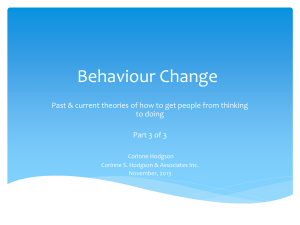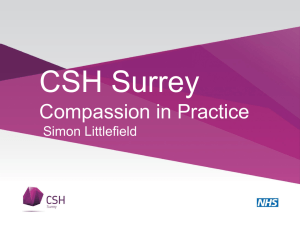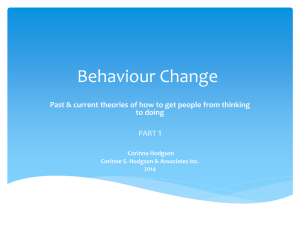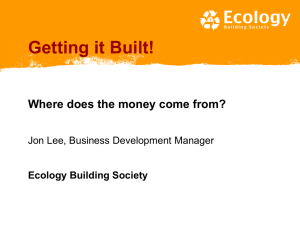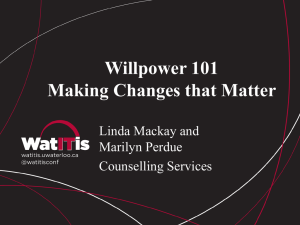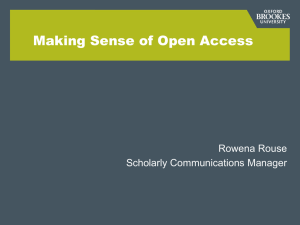BehaviourChangePresentation_CHodgson_Part2
advertisement
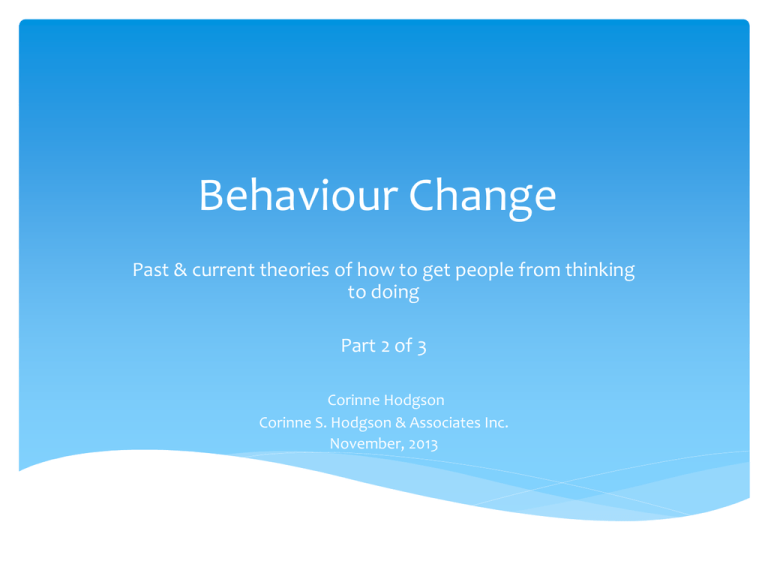
Behaviour Change Past & current theories of how to get people from thinking to doing Part 2 of 3 Corinne Hodgson Corinne S. Hodgson & Associates Inc. November, 2013 Overview Part 1 Traditional theories such as Transtheoretical Model, Model of Reasoned Action/Planned Behaviour, and Social Cognitive Theory Opportunities from other areas of psychology: achievement theory, self theory, and self-determination theory Part 2: Health Action Process Approach and SelfRegulation Part 3: New models from interactive health (Fogg, Eyal) CSH Associates - From thinking to doing 2 Health Action Process Approach (Schwarzer, 2008) There are 2 phases: Motivational – development of intention Volitional – moving from intention to behaviour CSH Associates - From thinking to doing 3 Task Self-Efficacy Action Planning Outcome Expectancies Recovery Self-Efficacy Action Control INTENTION Coping Planning Risk Perception PREINTENDERS CSH Associates - From thinking to doing ACTION Barriers & Resources (e.g., Social Support) INTENDERS The Motivation Phase 4 ACTORS The Volitional Phase Disengagement Maintenance Self-Efficacy Step 1: Intentional Paint a positive picture of benefits so expectancies are high To be effective, expectancies shouldn’t conflict with personal or societal norms Support feelings of self-efficacy (“I can do that!”) Risk messaging (i.e., need for prevention) may contribute but research suggest approach goals may be more effective than avoidance goals CSH Associates - From thinking to doing 5 Step 2: Volitional Volitional phase consists of different groups of people: Those who intend to change but haven’t started yet Motivated to change but don’t act because they lack skills to get started Key strategy to help them is action planning Those who have translated intentions into action Face two key challenges: Coping – need to plan how to anticipate & dealt with barriers Recovering -- how to get back on track after relapse/failure CSH Associates - From thinking to doing 6 Key volitional factors Action planning Most proximal predictor of behaviour Involves developing a precise mental representation of when, where and how Self-efficacy Confidence that you can cope Confidence that you can recover from set-backs Action control or self-regulation Ability to control your behaviour (e.g., delay gratification & stick to intentions) Can involve self-monitoring, automaticity & willingness to make effort Sniehotta ff et al. Psychology & Health 2005;10:143-60 7 CSH Associates - From thinking to doing Promoting “optimistic self-beliefs” (action/task self-efficacy) 1. Promote growth mindset – you’re not stuck with the way you are but have the capacity to change. Help users to challenge negative assumptions about their ability to change. 2. Explain rationale for & benefits (expectancies) of change. 3. Position change as the desirable or societal default. Jeni Cross – Three Myths of Behavior Change – What You Think You Know That You Don’t TED Talk CSH Associates - From thinking to doing 8 Support action planning People need choice so they feel they have control (autonomy) BUT Too much choice can be detrimental: Analysis paralysis as people try to compare opportunity costs of acting/not acting or between different options Buyer’s remorse or fear of buyer’s remorse: no choice can ever meet high expectations Self-blame (“I made a mistake; made wrong choice.”) Barry Schwartz, The Paradox of Choice, Why More is Less CSH Associates - From thinking to doing 9 Action planning (cont.) Action plan should address user’s basic psychological need for Relatedness Autonomy Competence Note: balance between psychological needs may vary between individuals – everyone is different Promote integrating behaviour into personal belief system – from “I should” to “I want to because…” Action plan should include strategies for maintaining self-efficacy & willpower even when faced with challenges & ego depletion CSH Associates - From thinking to doing 10 Promote coping self-efficacy 1. As with intention, promote growth mindset – change is possible. 2. Promote self-regulation & ability to delay gratification. 3. Start with the understanding that relapse is likely & normal so you need to develop a plan for when it occurs. Use cognitive behaviourial theory (CBT) strategies to help people change their perceptions (e.g., relapse is not failure), identify triggers, & develop strategies for avoiding high-risk situations. Use strategies such as self-monitoring, modeling, role playing, and brainstorming – but don’t use a “super achiever” as a model. 4. Build incrementally on achievable goals (e.g., it is common for people to set unrealistic weight loss goals). Schwarzer & Fushs in Predicting Health Behaviour: Research and Practice with Social Cognition Models, 11 CSH Associates - From thinking to Conner & Norman, eds. (1995) doing Self-regulation & willpower Self-regulation theory states personal health management includes skills such as impulse control and being able to delay immediate gratification for long-term gain Being conscientious in health reflection of larger construct of conscientiousness Elements of self-regulation: Standards (norms) that you want to meet Motivation to meet standards Monitoring of situations & thoughts that could lead to breaking standards Willpower or internal strength to control urges Baumeister et al. Losing Control: How and Why People Fail at Self-Regulation (1994) 12 CSH Associates - From thinking to doing Willpower Willpower as a muscle – Beaumeister & Tierney If you use it, you wear it out >> ego depletion But at the same time, you can strengthen it through regular training Baumeister & Tierney. Willpower, Rediscovering the Greatest Human Strength (2011) CSH Associates - From thinking to doing 13 Ego Depletion Making changes (esp. dieting) imposes a high decisional burden so is mentally tiring A variety of factors consume mental energy, makes it harder to concentrate, & leave you more vulnerable to relapses: Having to pretend or ignore something: “White Bear effect”; trying to pretend you like someone you don’t Repeated exposure to temptations (same or different) Physical fatigue – low blood glucose, lack of sleep Poverty (UBC/Princeton study in Science, 2013) Goal-conflict (more) CSH Associates - From thinking to doing 14 Goal Conflict People have goals in multiple areas of life (health, career, family, social life) – sometimes goals can facilitate one another but other times they can conflict (e.g., dinner out with friends vs. going to gym) Even negative behaviours may address a variety of needs (e.g., smoking may enhance sense of relatedness with other smokers) A short term-goal is typically easier to choose over a long-term goal, particularly if you have a short-term temporal orientation << Philip Zimbardo The Time Paradox In our obesogenic environment, there is lots of negative goal priming in your environment (e.g., advertising for high-fat foods) CSH Associates - From thinking to doing 15 Goal Conflict (2) How people experience & handle goal conflict varies with: Personality traits (e.g., conscientious people shape environment to avoid temptation, although they may not be any better at resisting temptation) Situational factors such as setting or alcohol Interpersonal factors -- people around you can be good or bad models or remind you of social norms Study found people feel desires all the time and 47% of the time they conflict with some goal, value or motivation Strong self-regulatory skills & being able to resist desires can decrease giving in to them from 70% to 17% Hoffman et al J Personality & Social Psychology 2012; Bourdreax et al Motivation & Emotion 2013 CSH Associates - From thinking to doing 16 Goal conflict as barrier to regular physical activity 11 studies by Dan Bailis, University of Manitoba In studies, subjects were 1) asked to commit to exercising and then 2) primed with either conflict (e.g., academic) or consistent (exercise) goal messaging Goal conflict increased negative affect (guilt, shame) and decreased positive affect, perceived ability and amount of exercise – when inactivity is due to goal conflict, intentions lead to frustration rather than action You can reduce goal conflict by: Action planning (e.g., scheduling time to exercise) Framing messages that stress benefits of exercising and costs of not doing it CSH Associates - From thinking to doing 17 Reducing ego depletion & building your willpower muscle Experiments have shown that making even simple changes (sitting up straight, using your left hand) for 2 weeks can build willpower as measured by ability to concentrate on a task or hold hand-grip strength Order in one part of life (e.g., exercise) has been shown to affect other areas of life (diet or housecleaning) - Peter Walsh, Does This Clutter Make My Butt Look Fat? (2008) Adequate sleep and keeping blood glucose in healthy range can help to shore up willpower “Public information has more impact than private information” – mirrors, self-monitoring & knowing that you are being watched increases self-regulation/willpower << Quantified Self movement CSH Associates - From thinking to doing 18 But .. Is willpower a muscle or a neural signal? Experiments have shown that even those who are ego-depleted can get a “second wind” Decision-making involves analysis of prospect for pain or pleasure by two neural systems: Reactive system for immediate prospects (amygdala) Reflective system for future prospects (prefrontal cortex) Ego-depletion may represent our own perception of our limits – signals from the amygdala hijack goal-driven cognitive resources needed for reflective system Exercises to “build” willpower may actually reinforce reflective neural pathways that allow reflective system to resist reactive system McGonigal The Willpower Instinct (2012); Noel et al. Psychiatry (Edgmonet) 2006;3(5):30-41 CSH Associates - From thinking to doing 19

